Crispy on the outside, fluffy on the inside, this beautiful gluten-free focaccia bread is super easy to make and deliciously good. This Italian rosemary focaccia is the perfect table bread for accompanying this tasty carrot turmeric soup or this creamy pumpkin soup. It’s also amazing as an appetizer with our popular easy creamy hummus, or even just with extra virgin olive oil! Gluten-free, dairy-free, and vegan too.
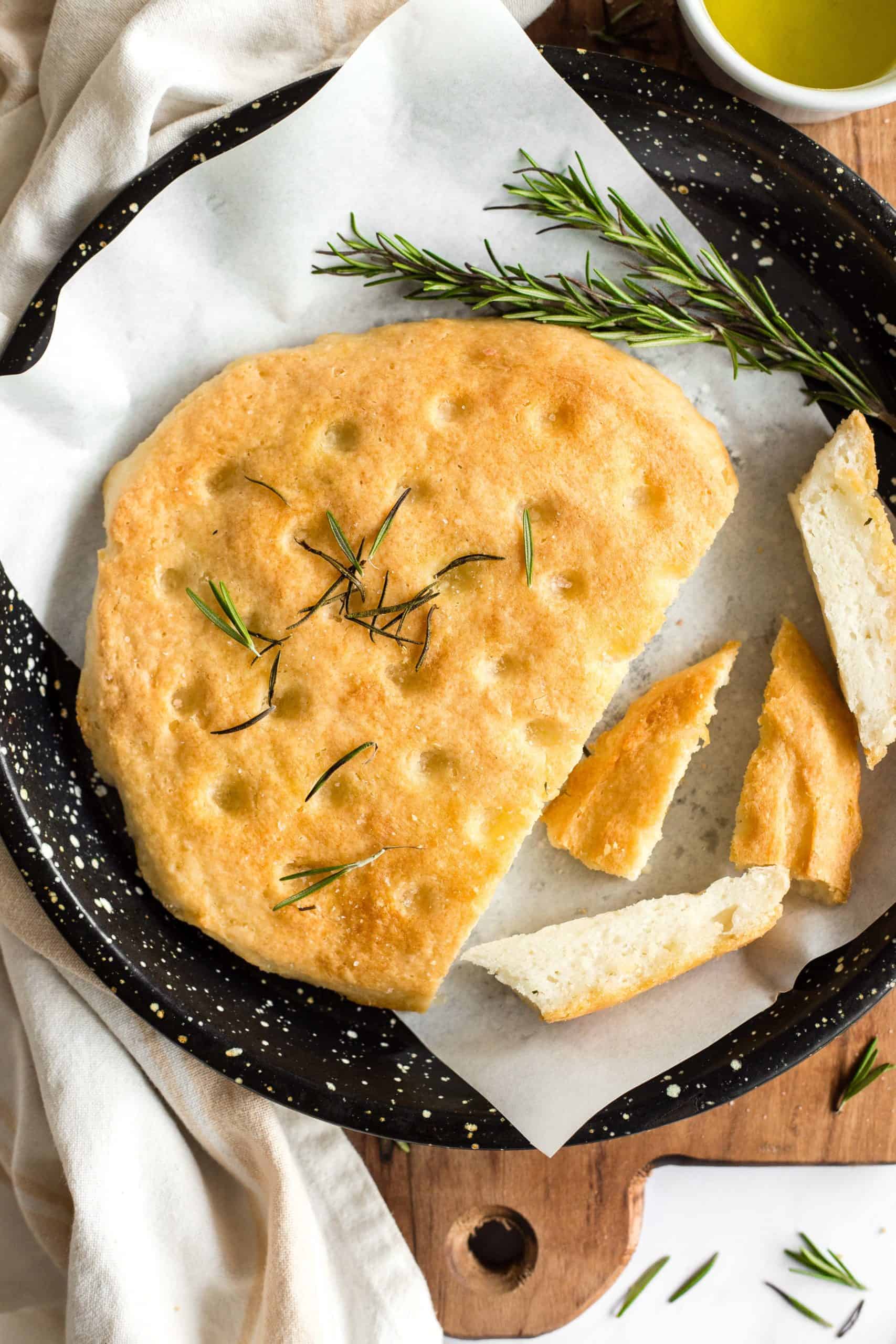
Want to save this recipe?
Enter your email & I’ll send it to your inbox. Plus, get great new recipes from me every week!
Jump to:
- Gluten-Free Bread Baking Adventures
- What is Focaccia Bread?
- Is Focaccia Gluten-Free?
- Why This Recipe Works
- Ingredients You’ll Need:
- Ingredient Notes/Substitutions:
- How to Make Gluten-Free Focaccia Bread (Step by Step):
- 5. Transfer Dough to Parchment-Lined Pan
- Dish by Dish Tips/Tricks:
- Recipe FAQs:
- What to Eat with this Rosemary Focaccia Bread?
- Other Gluten-Free Bread Recipes You’ll Also Love:
- Appetizers to Enjoy:
- Amazing Gluten-Free Focaccia Bread (Dairy-Free, Vegan)
Gluten-Free Bread Baking Adventures
Ever since I started baking bread again, I’ve experimented with quite a few different types of breads. Some of the savory baking experiments that were insanely successful include this gorgeous gluten-free no knead bread, this easy gluten-free no-yeast naan bread, and this amazing gluten-free pizza crust.
I’ve also been baking yeast bread recipes such as this crazy popular soft fluffy, buckwheat bread, tender gluten-free white bread, brown rice bread, quinoa bread, and sorghum bread.
One of the breads that has been on my “to-bake” list for the longest time was a gluten-free focaccia bread. And last week I finally got down to testing this easy focaccia recipe and we absolutely loved how it turned out.
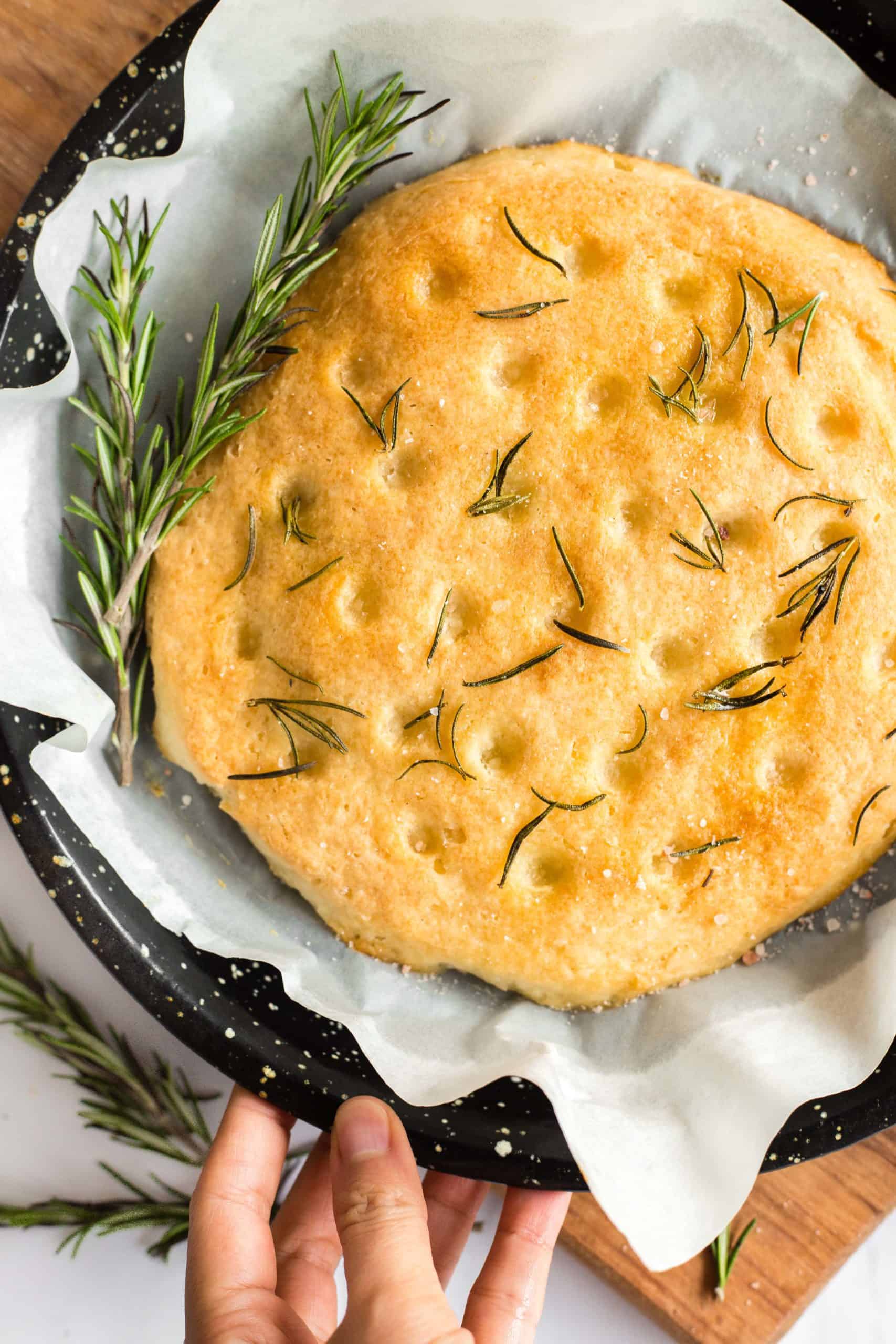
What is Focaccia Bread?
If you’ve never heard of focaccia bread before, or if it’s your first time attempting to make it, here’s some background on what it is and where it originated from.
Focaccia is a flat, oven-baked Italian bread that is similar in texture and taste to pizza dough. Mostly associated with Ligurian cuisine, focaccia comes with many variations and may sometimes be sweet and other times savory.
A main characteristic of focaccia is the appearance of dimples on its surface, which is formed by making small “craters” on the dough before it is baked.
One of the most commonly served types of focaccia is rosemary focaccia (or “focaccia al rosmarino” in Italian), which is often served as an antipasto, table bread, or appetizer in Italian cuisine.
Is Focaccia Gluten-Free?
Traditional focaccia is usually made with wheat flour (which contains gluten), and hence regular focaccia is not gluten-free.
However, I’ve got you covered with this gluten-free version of focaccia bread.
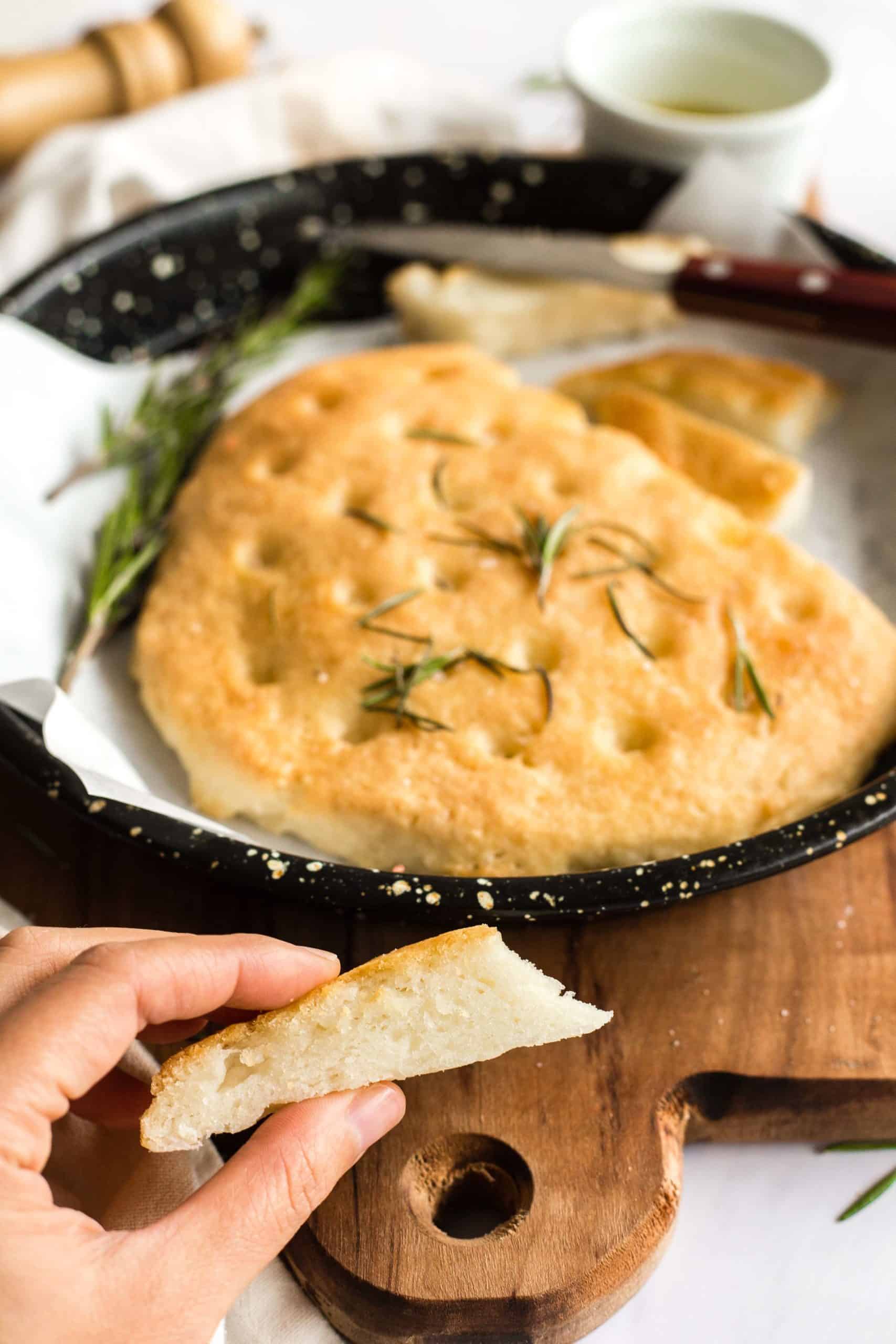
Why This Recipe Works
- Simple Ingredients: The ingredients required for this gluten-free focaccia bread recipe are easily available at the local grocery stores, and you might already have all the ingredients on hand (nothing fancy needed!).
- Soft, Fluffy, and Tender while Crusty: While it’s technically a flat bread, focaccia requires the use of yeast to create its fluffy interior (much like a pizza crust). This easy bread recipe yields the perfect texture in my opinion: it’s crusty on the outside, while amazingly soft, tender and fluffy inside! YUM!
- Easy to Make. No Kneading Required: Unlike normal wheat bread, there’s no kneading required as gluten-free dough doesn’t contain gluten and hence kneading is unnecessary (same logic for my easy gluten-free no knead bread).
- Gluten-Free, Dairy-Free, and Vegan: This delicious homemade focaccia is also totally gluten-free, dairy-free, and vegan, which means Celiacs, vegans, or those with gluten or dairy and lactose intolerances can totally enjoy it without worries!
Keep this easy recipe handy because I know you’ll be making it on repeat! Ready to get started? Let’s go!
Ingredients You’ll Need:
Here’s a visual overview of the ingredients you’ll need to make this gluten-free focaccia recipe.
(For exact quantities and measurements, please scroll down to the recipe card at the bottom of this post.)
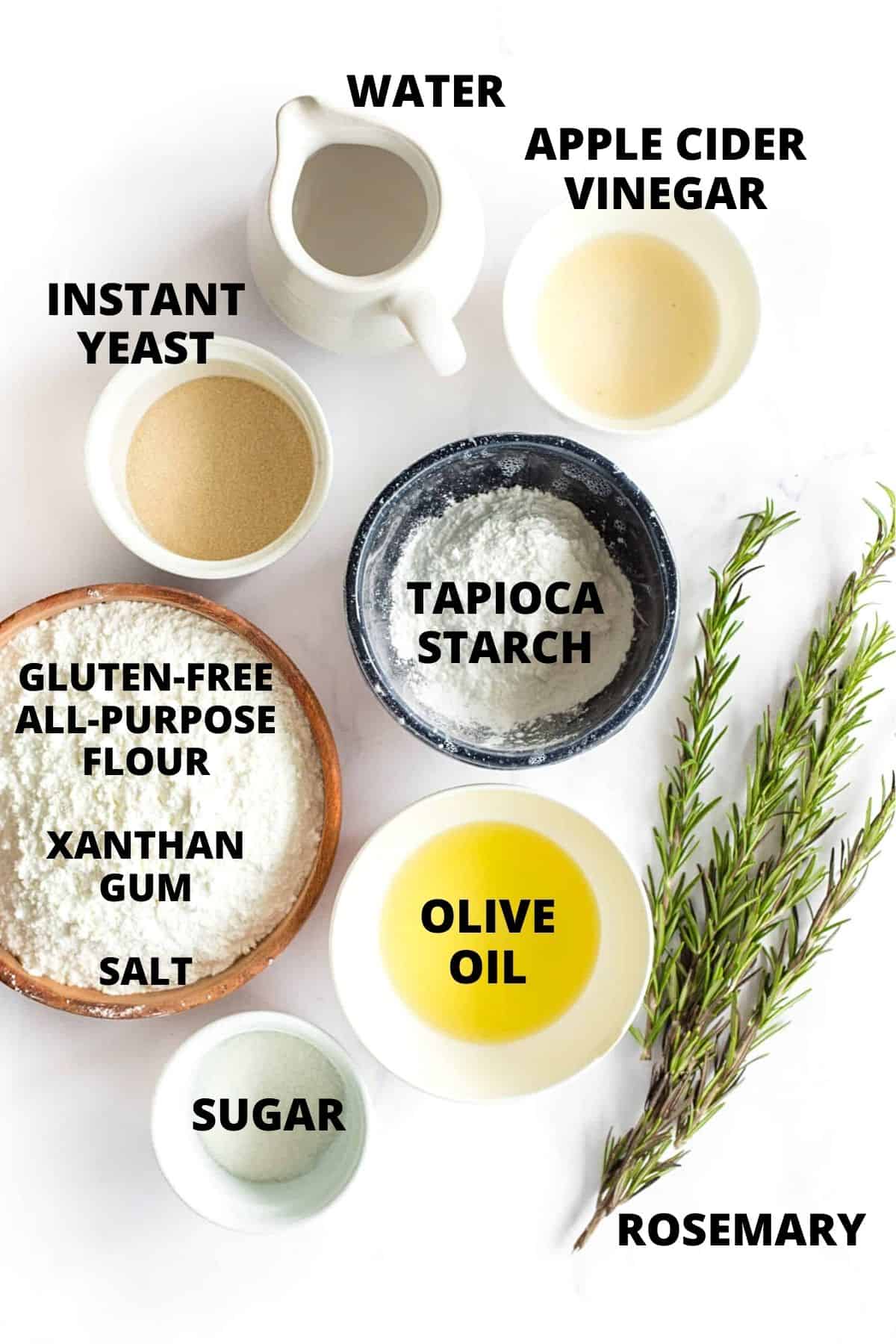
Ingredient Notes/Substitutions:
- Sugar: The sugar used is for the yeast to feed on so as to activate the yeast, so you cannot omit it. If you don’t want to use sugar, you can use the same amount of coconut sugar, or half the amount of maple syrup or honey. It will not make the bread sweet later.
- Instant Yeast: I like to use instant yeast as it activates immediately.
- Olive Oil: I highly recommend using extra virgin olive oil as it imparts a beautiful taste and color to the bread. Alternatively, you may use sunflower oil or avocado oil as well.
- Apple Cider Vinegar: Adding apple cider vinegar creates an acidic environment that helps the bread to rise even more.
- Gluten-Free All-Purpose Flour: For this gluten-free focaccia recipe, I recommend using a good-quality gluten-free all-purpose flour blend that uses lighter flours/starches (such as rice flour, corn starch, tapioca starch or potato starch) as that will ensure a lighter and fluffier texture. I do NOT recommend flour blends that use heavier flours (such as garbanzo bean flour) as that will result in a denser texture.
- Xanthan Gum: Xanthan gum is a substitute for gluten in gluten-free flours and is necessary to help the ingredients bind together. If your gluten-free flour blend does not include xanthan gum already, make sure to add is as stated in the recipe for best results.
- Tapioca Starch: If you don’t have tapioca starch (also known as tapioca flour), simply substitute it with the same amount of arrowroot starch or corn starch.
- Rosemary: This gluten-free focaccia recipe uses fresh rosemary leaves as a topping for extra flavor and color, but you could also top the focaccia with other fresh herbs such as oregano or garlic, or olives and even sun-dried tomatoes – the options are endless and basically up to you.
How to Make Gluten-Free Focaccia Bread (Step by Step):
1. Activate Yeast
In a medium-size bowl, combine the yeast, sugar, and warm water. Mix well and set aside for 5 minutes until it becomes foamy.
Tip #1: If the yeast mixture doesn’t foam, it means that the yeast has expired and no longer works. In this case, throw away the yeast mixture and start again with yeast from a fresh unopened packet.
Tip #2: If you’re wondering what sugar is doing in a savory bread recipe, it’s there as food for the yeast to feed on so the yeast will be activated. DO NOT omit the sugar because the yeast will not work otherwise. Don’t worry about the bread becoming sweet because once the yeast has fed on it, along with the salt that will be added, the bread will not taste sweet.
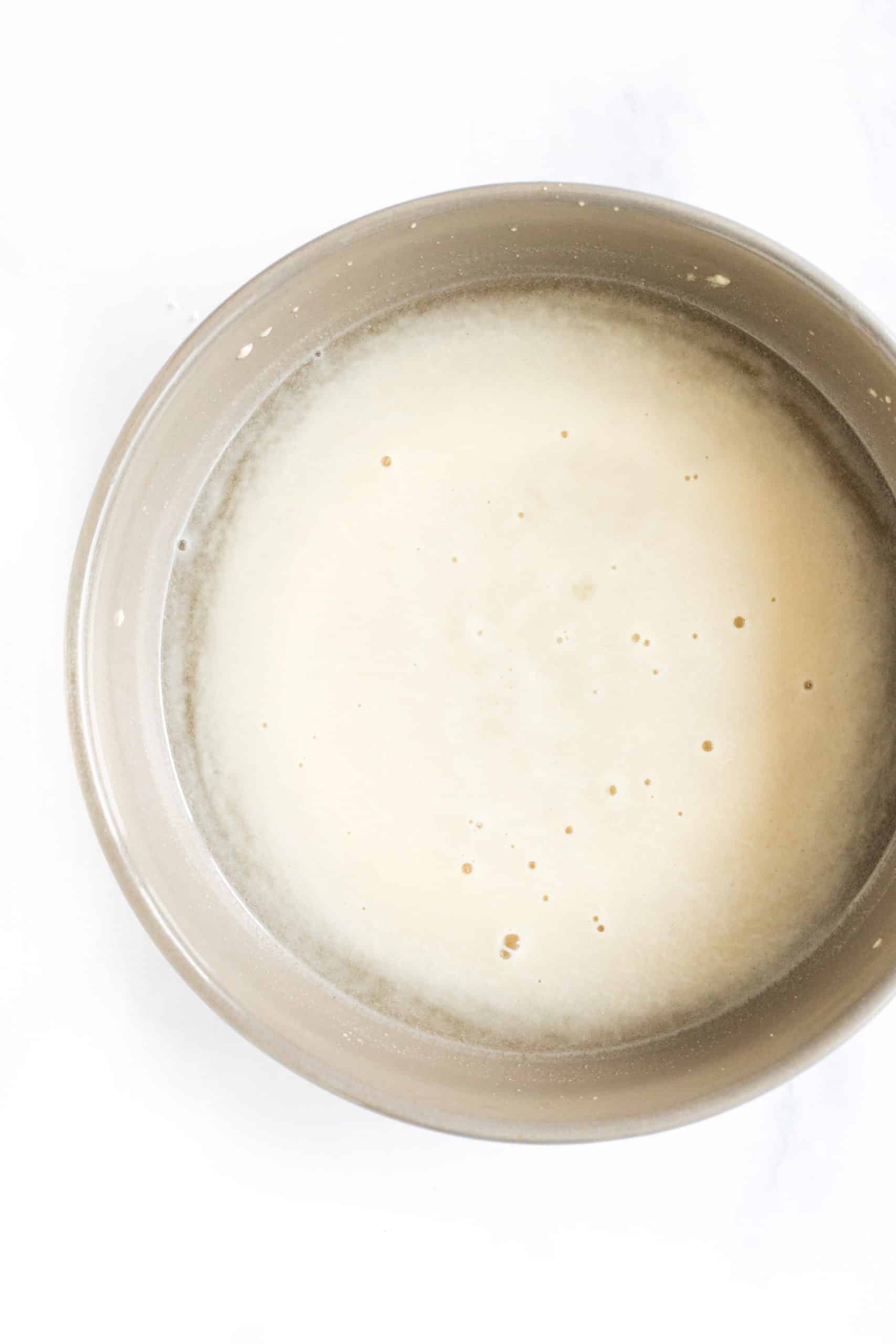
2. Combine Liquid Ingredients with Yeast Mixture
Once the yeast mixture is foamy, combine the yeast mixture with 1/4 cup olive oil, the apple cider vinegar in a large mixing bowl and mix well.
3. Whisk Dry Ingredients
In a large bowl, whisk the gluten-free all-purpose flour, xanthan gum (if using), tapioca starch, and sea salt to combine.
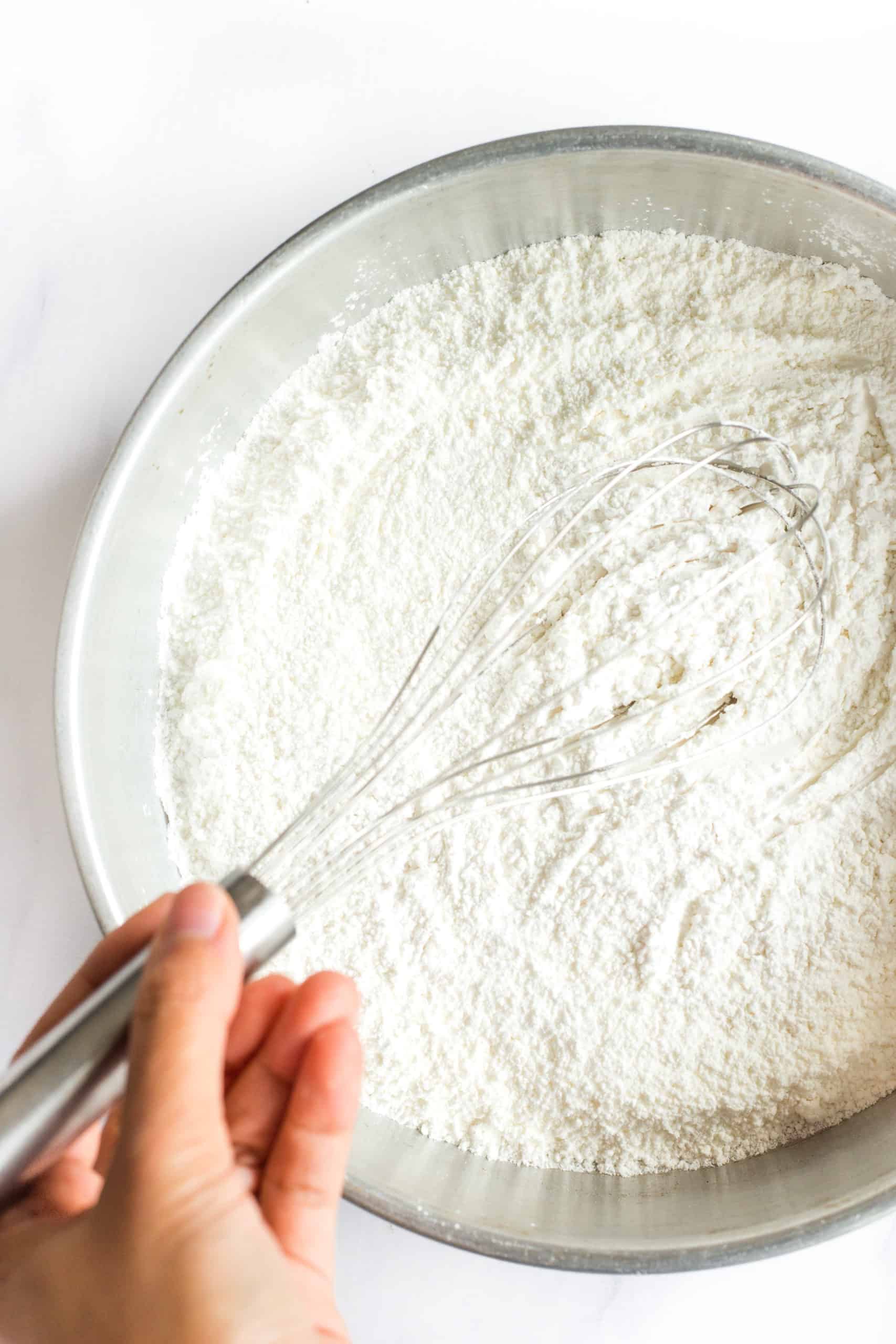
4. Add Dry Ingredients to Wet Ingredients to Form Dough
Add the flour mixture to the bowl with the wet ingredients and mix well until you get a homogeneous and sticky dough.
It is totally normal for the dough to be slightly wet and sticky because that’s the way gluten-free bread dough is. Don’t be tempted to add more flour or it will become hard and dry.
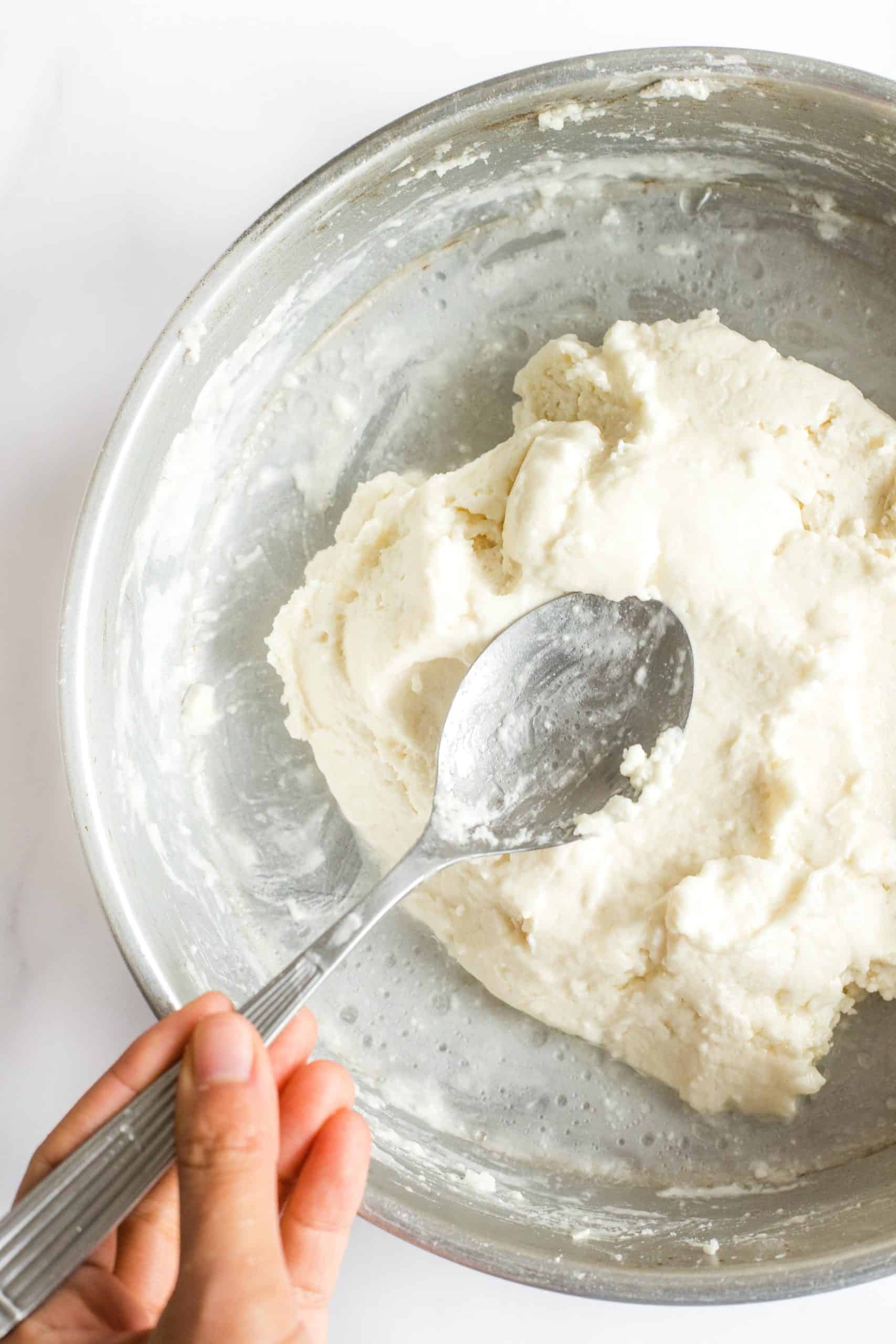
5. Transfer Dough to Parchment-Lined Pan
Line a round baking pan with parchment paper, grease the parchment paper with a bit of oil, and then transfer the dough to the prepared baking sheet. Spread the dough out into a 1.5-inch thick round disc, using wet fingers to shape the dough.
6. Let Dough Rise
Place the gluten-free focaccia bread dough in a warm place and let it rise for 45 minutes until it has increased in size (it will not double, but will have increased significantly in size and will look fluffier than before rising).
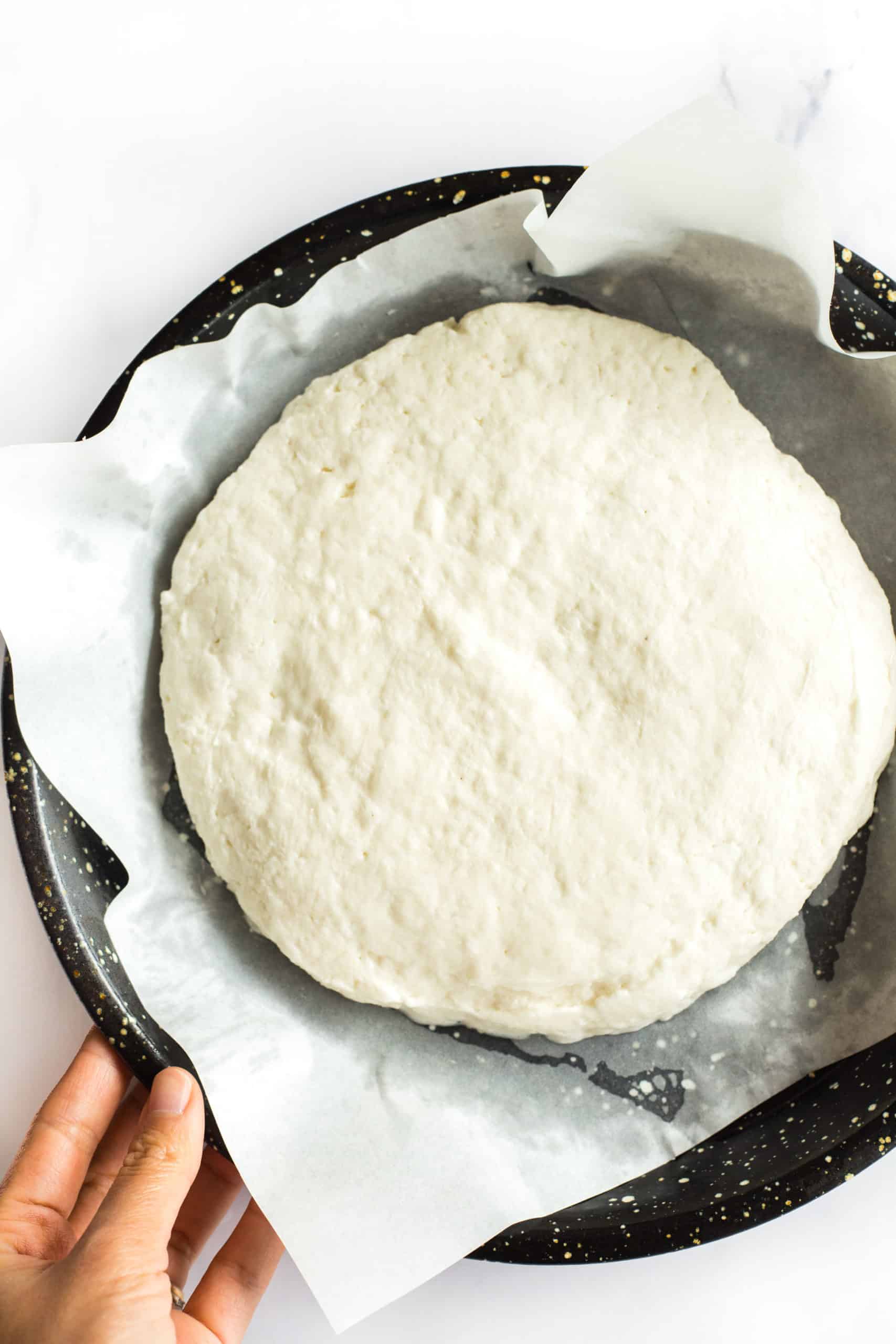
7. Preheat Oven
While the dough rises (during the last 10 minutes), preheat the oven to 400F.
8. Poke Dimples into Dough
After the gluten-free focaccia bread dough has risen, dip your pinky finger in water and use it to poke evenly-spaced dimples into the top of the bread dough.
(This will create the characteristic dimpled appearance that traditional Italian focaccia bread is so well know for.)
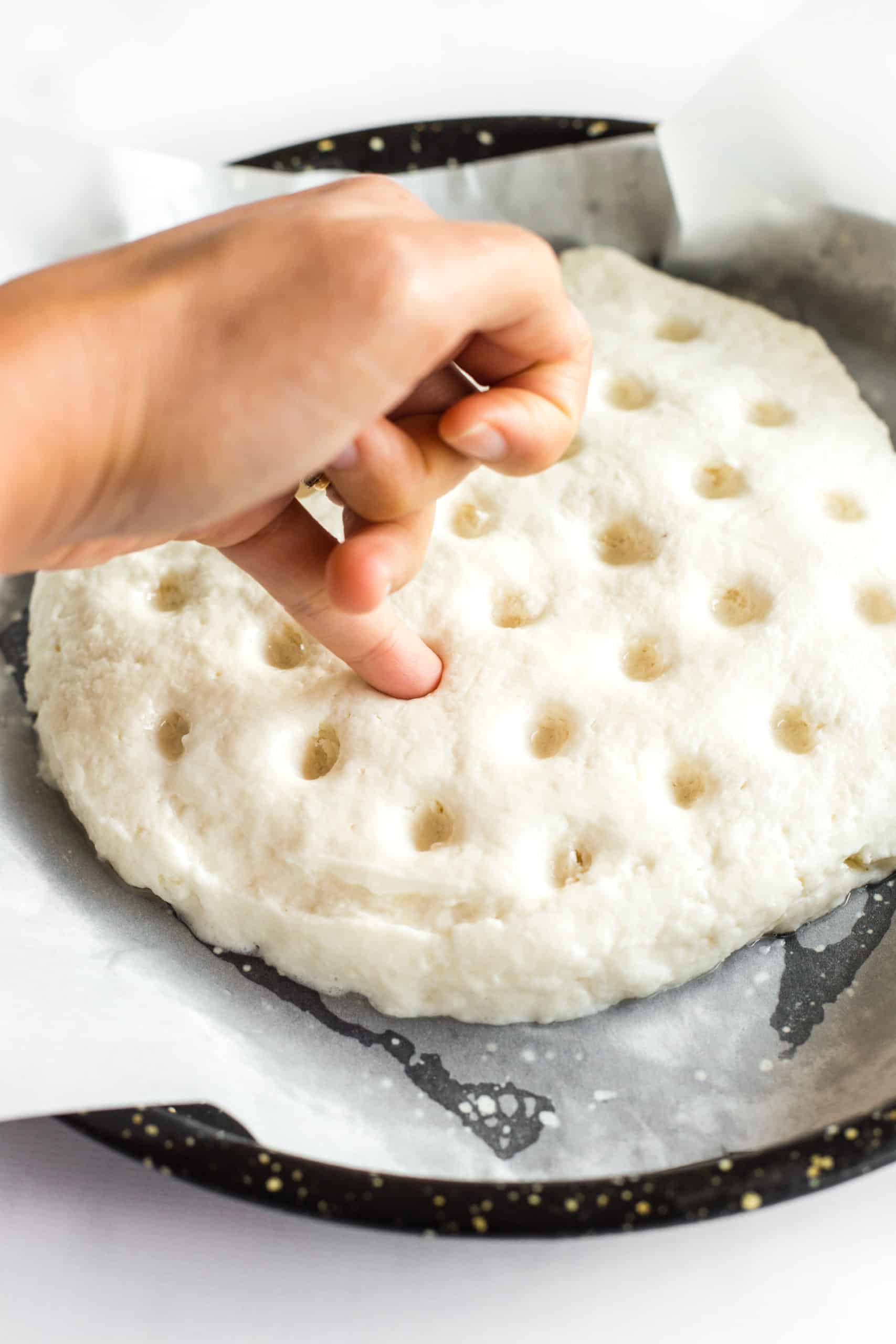
9. Brush and Sprinkle
Brush the dough with the remaining 2 tablespoons of olive oil, making sure that even part of the surface has been brushed (this will create a crusty, golden brown exterior once it’s baked).
After brushing with oil, sprinkle the surface with fresh rosemary leaves and sea salt.
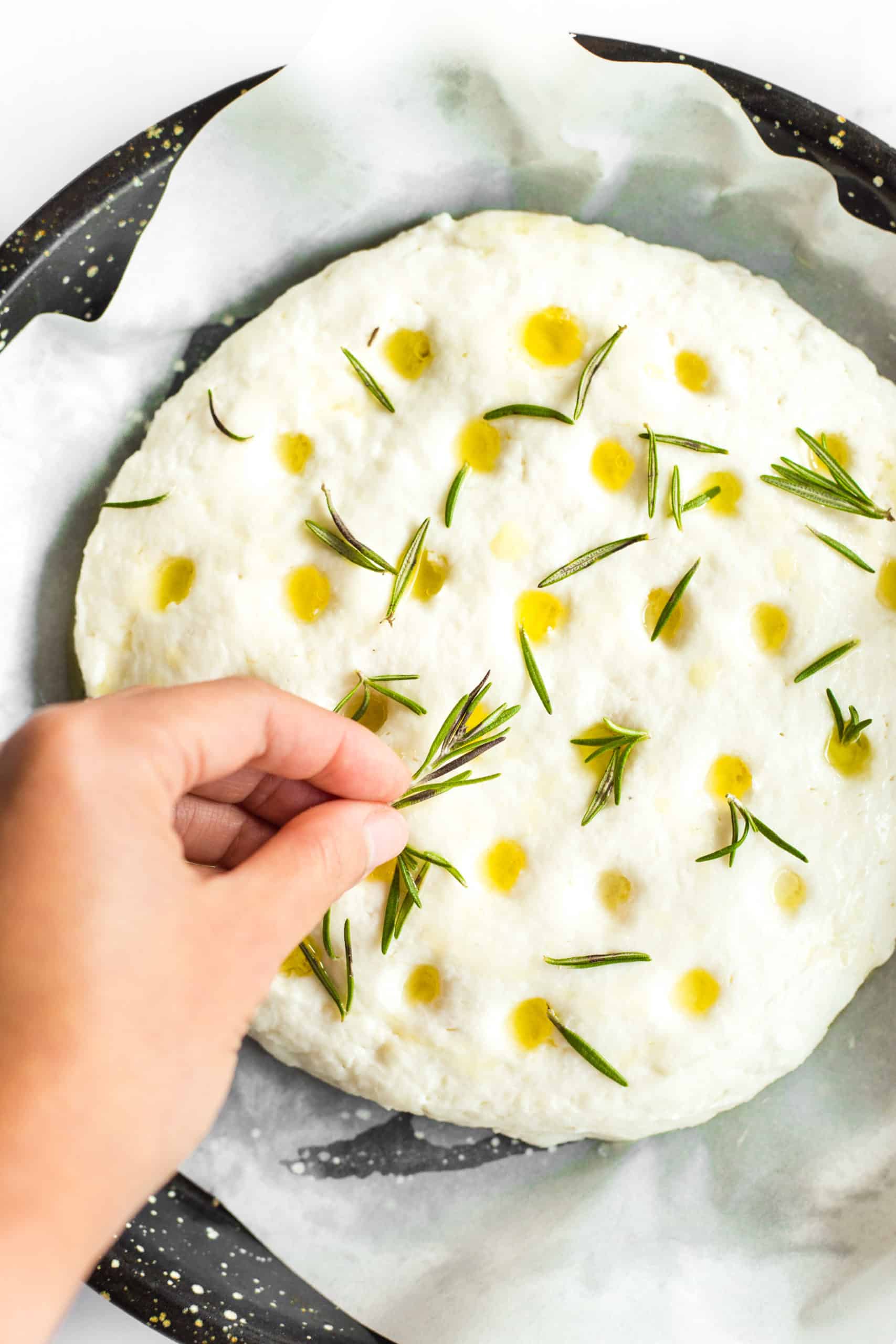
10. Bake Until Golden and Crusty
Bake the focaccia dough on the middle rack of the preheated oven for 45 to 55 minutes until the top is golden brown and crusty.
11. Cool Before Slicing
Let the gluten-free rosemary focaccia cool slightly at room temperature before slicing and serving warm.
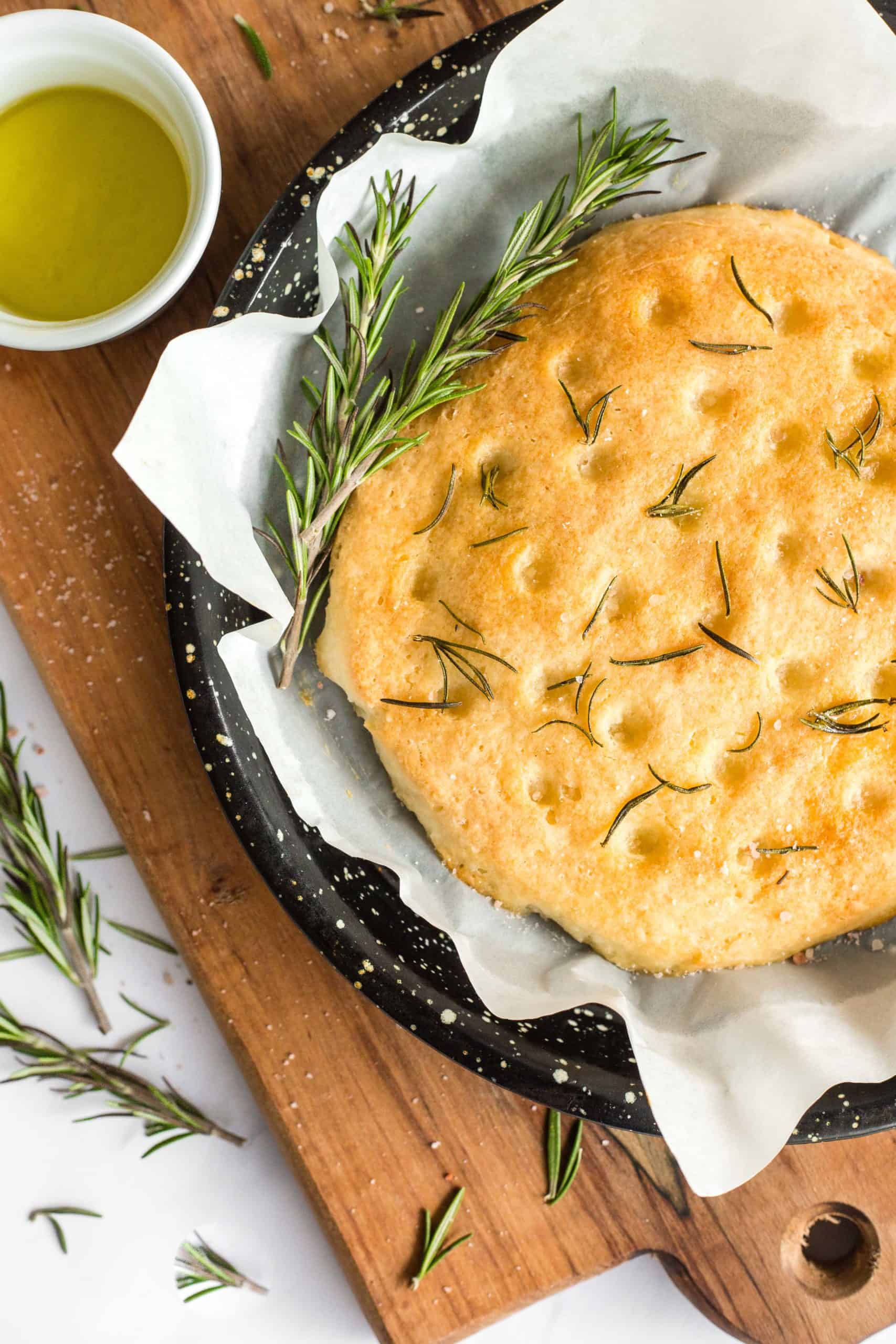
Dish by Dish Tips/Tricks:
- Herbs: If you don’t like rosemary, or prefer other herbs such as thyme, oregano, feel free to swap out the rosemary for the same quantity of other herbs instead. This gluten-free focaccia recipe uses fresh rosemary, but if you plan on using dried rosemary, make sure to use 1/3 the amount of dried herbs as dried herbs are much more concentrated in taste.
- Additional Toppings: You may also add olives or cherry tomatoes to this gluten-free focaccia bread for extra flavor and taste. You can also sprinkle the focaccia with flaky sea salt and freshly ground black pepper or red pepper flakes on top of the dough if you enjoy a bit of heat.
- Line With Parchment Paper: Make sure to line your baking sheet with parchment paper so that the bottom crust does not stick to the pan.
Recipe FAQs:
To store, place the cooled gluten-free rosemary focaccia in an airtight container or wrap it in plastic wrap and store in the refrigerator for up to a week.
Yes you can freeze this focaccia bread. To freeze, place the cooled focaccia bread in a freezer-safe container or ziplock bag and freeze for up to 3 months. Let the frozen focaccia thaw completely overnight in the refrigerator before toasting or warming up in the oven.
What to Eat with this Rosemary Focaccia Bread?
Now that the baking and waiting if finally over, it’s finally time to dig in! I can’t wait, and I’m betting you can’t help but want a bite of this gorgeous gluten-free focaccia bread. The question is – what do you eat with it? There are so many foods you can eat with this Italian rosemary focaccia, but here are some of my favorites:

Other Gluten-Free Bread Recipes You’ll Also Love:
- Easy Gluten-Free Naan Bread (Dairy-Free)
- Easy Gluten-Free No Knead Bread (Dairy-Free)
- Easy Gluten-Free Sandwich Bread
- Gluten-Free Honey Oat Quick Bread
- Gluten-Free Skillet Cornbread
- 10 Easy Gluten-Free Bread Recipes to Make on Repeat
Appetizers to Enjoy:
P.S. If you try this recipe, I’d love for you to leave a star rating below, and/or a review in the comment section further down the page. I always appreciate your feedback. Be sure to check out my entire Recipe Index for all the recipes on the blog. You can also follow me on Pinterest, Facebook or Instagram! Sign up for my Email List to get fresh recipes in your inbox each week!
Print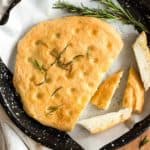
Amazing Gluten-Free Focaccia Bread (Dairy-Free, Vegan)
- Total Time: 1 hour 50 minutes
- Yield: 8 servings 1x
- Diet: Gluten Free
Description
Crispy on the outside, fluffy on the inside, this beautiful gluten-free focaccia bread is super easy to make and deliciously good. This Italian rosemary focaccia is the perfect table bread for accompanying this tasty carrot turmeric soup or this creamy pumpkin soup. It’s also amazing as an appetizer with our popular easy creamy hummus, or even just with extra virgin olive oil! Gluten-free, dairy-free, and vegan too.
Ingredients
- 1 cup warm water (between 105F to 115F)
- 1 tablespoon sugar
- 1 1/4 teaspoons instant yeast
- 1/4 cup extra virgin olive oil, plus 2 tablespoons for brushing
- 1 teaspoons apple cider vinegar
- 1 3/4 cups gluten-free all-purpose flour
- 1/2 teaspoon xanthan gum (omit if your blend already includes it)
- 1/4 cup tapioca starch
- 2 teaspoons sea salt, plus more for sprinkling
- 1 tablespoon fresh rosemary leaves, optional but highly recommended
Instructions
- Activate Yeast: In a medium-size bowl, combine the yeast, sugar, and warm water. Mix well and set aside for 5 minutes until it becomes foamy. If the yeast mixture doesn’t foam up after 5 minutes, that means that the yeast has expired and is no longer working. Throw it away and use yeast from a fresh packet.
- Combine Liquid Ingredients with Yeast Mixture: Once the yeast mixture is foamy, combine the yeast mixture with 1/4 cup olive oil, the apple cider vinegar in a large mixing bowl and mix well.
- Add Dry Ingredients: Add the gluten-free all-purpose flour, xanthan gum (if using), tapioca starch, and salt to the bowl and mix well until you get a sticky but homogeneous dough (it is totally normal for the dough to be slightly wet and sticky because that’s the way gluten-free bread dough is. Don’t be tempted to add more flour or it will become hard and dry).
- Transfer Dough to Parchment-Lined Pan: Line a round baking pan with parchment paper, grease the parchment paper with a bit of oil, and then transfer the dough to the pan. Spread the dough out into a 1.5-inch thick round disc, using wet fingers to shape the dough.
- Let Dough Rise: Place the dough in a draft-free space and let it rise for 45 minutes until it has increased in size (it will not double, but will have increased significantly in size).
- Preheat Oven: Preheat the oven to 400F.
- Poke Dimples into Dough: After the dough has risen, dip your pinky finger in water and use it to poke evenly-spaced dimples into the dough.
- Brush with Olive Oil: Brush the dough with olive oil, making sure that even part of the surface has been brushed (this will create a crusty, golden brown exterior once it’s baked). Sprinkle the surface with fresh rosemary leaves and salt.
- Bake Until Crusty: Bake on the middle rack for 45 to 55 minutes until the top is golden brown and crusty.
- Cool Before Slicing: Let focaccia bread cool slightly before slicing and serving warm.
Notes
Sugar: The sugar used is for the yeast to feed on so as to activate the yeast, so you cannot omit it. If you don’t want to use sugar, you can use the same amount of coconut sugar, or half the amount of maple syrup or honey. It will not make the bread sweet later.
Instant Yeast: I like to use instant yeast as it activates immediately.
Olive Oil: I highly recommend using extra virgin olive oil as it imparts a beautiful taste and color to the bread. Alternatively, you may use sunflower oil or avocado oil as well.
Apple Cider Vinegar: Adding apple cider vinegar creates an acidic environment that helps the bread to rise even more.
Gluten-Free All-Purpose Flour: I recommend using a good-quality gluten-free all-purpose flour blend that uses lighter flours/starches (such as rice flour, corn starch, tapioca starch or potato starch) as that will ensure a lighter and fluffier texture. I do NOT recommend flour blends that use heavier flours (such as garbanzo bean flour) as that will result in a denser texture.
Xanthan Gum: Xanthan gum is a substitute for gluten in gluten-free flours and is necessary to help the ingredients bind together. If your gluten-free flour blend does not include xanthan gum already, make sure to add is as stated in the recipe for best results.
Tapioca Starch: If you don’t have tapioca starch (also known as tapioca flour), simply substitute it with the same amount of arrowroot starch or corn starch.
Rosemary: This recipe uses fresh rosemary leaves as a topping for extra flavor and color, but you could also top the focaccia with other fresh herbs such as oregano or garlic, or olives and even sun-dried tomatoes – the options are endless and basically up to you.
Serve this With: Extra virgin olive oil is my favorite choice when serving this gluten-free focaccia as table bread. If not, you can use the bread to accompany soups such as my favorite vegan pumpkin soup or this delicious carrot turmeric soup. You can also serve this bread alongside our easy creamy hummus or grilled eggplant sesame dip.
Storing/Freezing: To store, place the cooled gluten-free focaccia in an airtight container or wrap it in plastic wrap and store in the refrigerator for up to a week. To freeze, place the cooled focaccia bread in a freezer-safe container or ziplock bag and freeze for up to 3 months. Let the frozen focaccia thaw completely overnight in the refrigerator before toasting or warming up in the oven.
This recipe was originally published in June 2020, but has since been updated to include recipe notes and ingredient substitutions, clearer instructions and step-by-step photos.
- Prep Time: 55 mins
- Cook Time: 55 mins
- Category: Bread
- Method: Baking
- Cuisine: Italian
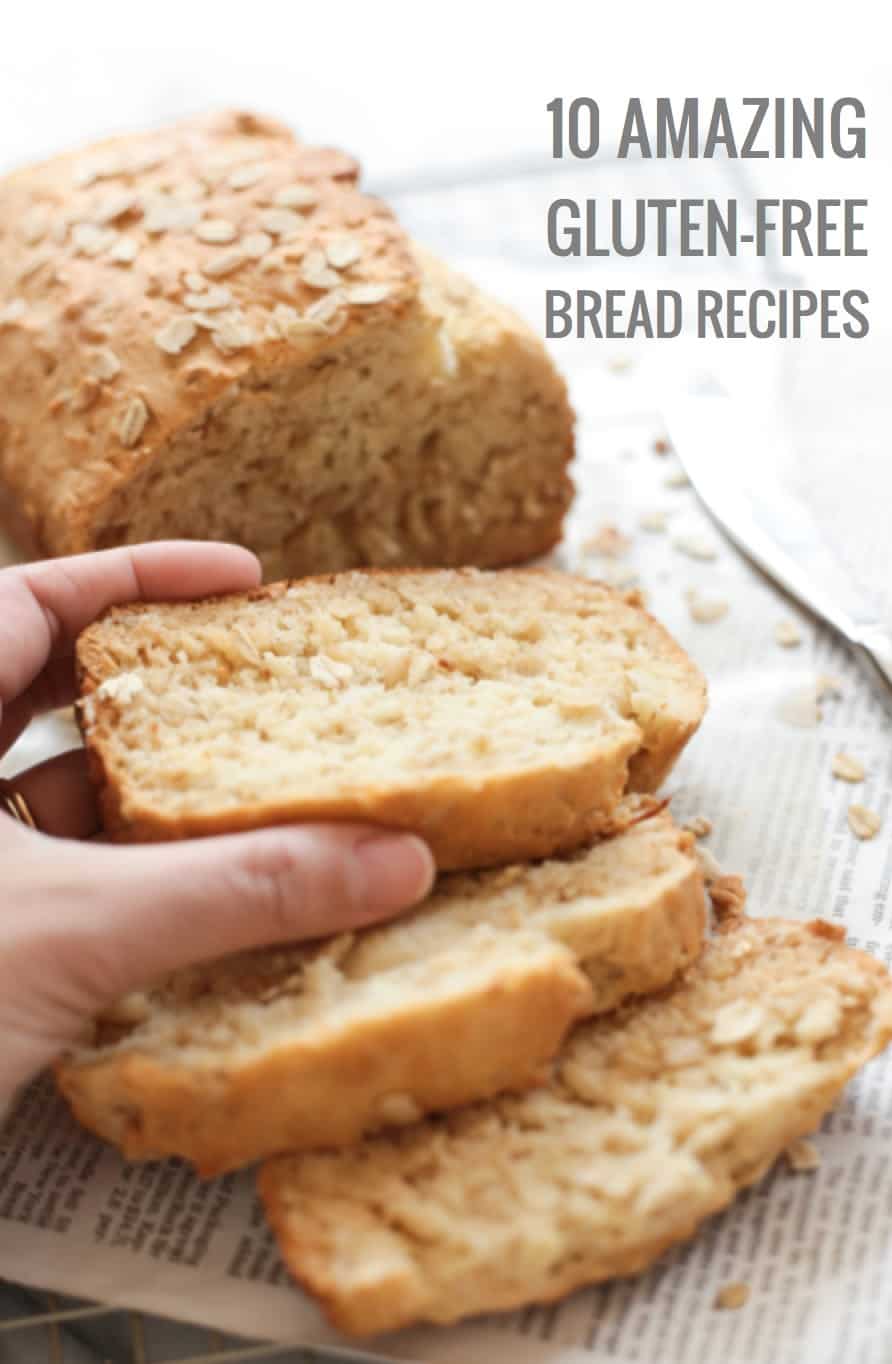

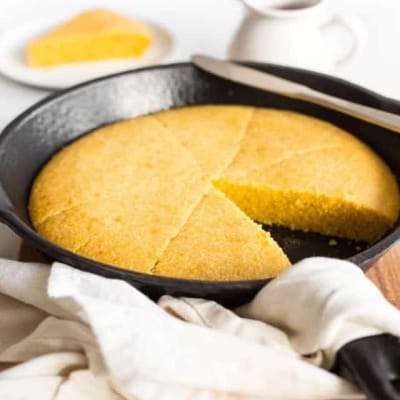
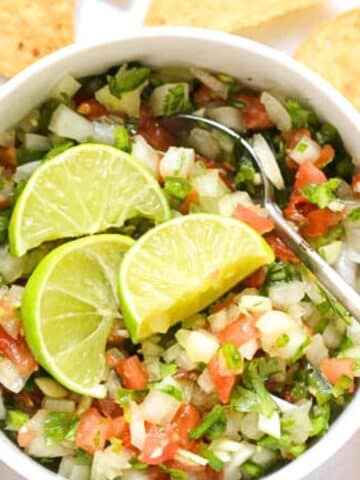
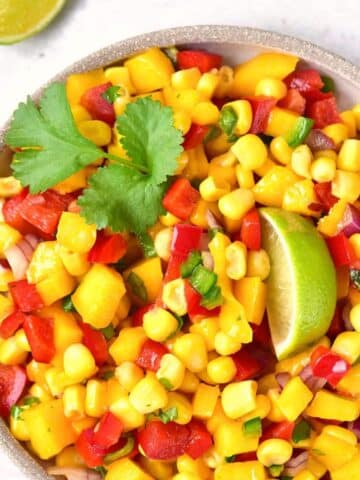
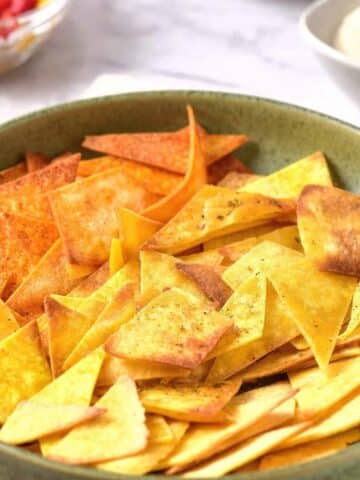
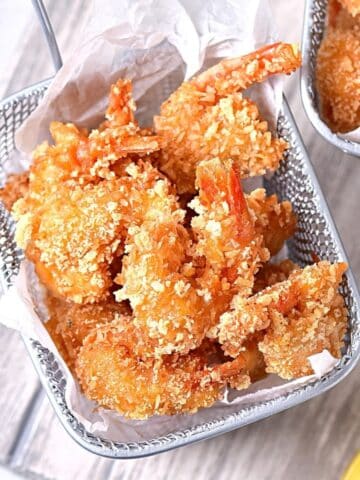
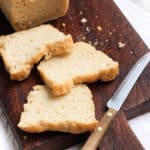
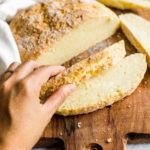
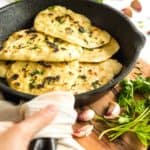
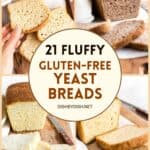

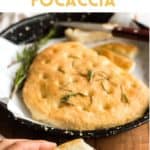
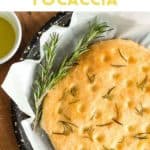
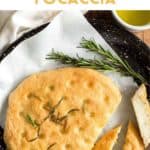
Can you make this with almond flour to reduce the carbs?
Ann
Hi Ann!
I believe you can, but I wouldn’t replace all the GF flour blend with almond flour as that might result in a denser texture.
You can try substituting 3/4 cup of the GF flour blend with finely ground blanched almond flour, so you get less carbs but still achieve a fluffy texture.
Hope this helps!
xx
Felicia
this is the best! I now make this every Sunday for our family spaghetti dinner. Thanks for the recipe 🙂
Hi Cindy!
I’m so happy to hear that – Sunday night spaghetti dinner sounds like a beautiful tradition! Thank you for your sweet note, and I hope to see you around the blog again sometime soon!
xx,
Felicia
Have had Celiac Disease for many years. I have tried many focaccia recipes but none compared to this one. Loved the crusty outside !! I used Bob’s Red Mill GF flour.
Thank you for this easy , amazing recipe. I will be making it often. Serv d it tonight with homemade Lentil soup.
Hi Lynn,
I’m so happy to hear this! Thank you for sharing how it went, and I’m glad you loved this focaccia. That homemade lentil soup sounds amazing btw!
Hope to see you on the blog again sometime soon.
xx,
Felicia
I am so excited to make this. My question is, the GF flour I will use has tapioca flour in its blend. Do I still use the amount you have listed in the ingredients? Thank you!
Hi Diane, yes that’s fine. Tapioca flour is the same as tapioca starch, which is what many blends use. Make sure your blend includes xanthan gum though!
Good morning Felicia,
This is definitely a great bread to bake.
More than this, I greatly appreciate the tips and tricks you shared in your blog-posts which help us to avoid unnecessary cooking failure. In this particular recipe, I am referring to the activation of instant yeast:
Tip #1: If the yeast mixture doesn’t foam, it means that the yeast has expired and no longer works. In this case, throw away the yeast mixture and start again with yeast from a fresh unopened packet.
Tip #2: If you’re wondering what sugar is doing in a savory bread recipe, it’s there as food for the yeast to feed on so the yeast will be activated. DO NOT omit the sugar because the yeast will not work otherwise. Don’t worry about the bread becoming sweet because once the yeast has fed on it, along with the salt that will be added, the bread will not taste sweet.
Thank you Darling!
With much love,
Mum
Hi mummy, so glad you found the tips useful! Hopefully the tips are useful to everyone who reads them too!
I’ve been gluten-free for 9 years since I discovered I have celiac disease and I have missed yeast bread terribly. This bread is perfect! Thank you for the recipe. We make this bread several times a week now because it is so easy and so good.
Hi Charles,
Thank you so much for letting me know!! You just made my day – so glad you and your family enjoy this focaccia (my husband Juan has been Celiac for the past 6 years and he loves it too). Gluten-free bread can sometimes be difficult to make well, so I’m very happy this focaccia recipe turned out well for you! Again, thanks for your comment and amazing review. Hope to see you around the blog again sometime soon!
Felicia.
A very fuss free , easy recipe . The insides were soft however the outside was crispy/ hard making it tough to cut through. I baked the bread for 55mins. Is there a way to avoid it being too crispy?
Thank you
Hi Emma, thanks for your note!
What you can do is to tent the focaccia with aluminum foil in the last 15 mins of baking to prevent the outside from being too crusty (bear in mind that each oven is different and whether the bread was baked on the bottom rack/middle rack makes a difference). The higher the rack it was baked on, the faster the crust hardens/browns. So using the foil will help to prevent it from being cooked too much, while still allowing the insides to continue cooking. Hope this helps dear! Also, make sure you use a serrated knife (knife with a tooth-edge) for cutting breads as serrated knifes are perfect for baked goods with hard crust and soft insides – and will prevent the bread from being squished/flattened as you cut it. If you use a smooth-edged knife, it will be hard to cut, and it will flatten the focaccia too!
Hi Felicia,
I am new to GF cooking/baking and there is so much to learn! If I use King Arthur Measure for Measure flour, do I still need to add the additional 1/4 cup of tapioca starch to the recipe?
Thanks!
Lisa
Hi Lisa! Welcome to the world of GF baking/cooking! Indeed there’s always something new to learn … GF baking is like a lifelong adventure and I learn something new every time I bake! In this case, I would still recommend the tapioca starch, but maybe you could reduce it to 1/8 cup instead. Hope it turns out well, would love to hear how it goes 🙂
Hi Felicia, it looks like a great recipe and I would like to try it. What GF All purpose flour are you using? Also, was it a recipe that you modified to GF. I ask because I have my mother in law regular flour focaccia recipe that very similar in what you make. The recipe calls for mashed potato to be combined with the dough after flour mixed with yeast. I think I would like to make a GF version of my mother in law focaccia and experiment.
Hi Julia! The gluten-free AP flour I used is a brand from Argentina (made mostly of rice flour, corn starch, and tapioca starch and is dairy-free). I believe you can use the King Arthur all-purpose gluten-free flour, it should work in your mother-in-law’s focaccia recipe if you’re planning to make it GF 🙂 Hope it works!! All the best, and would love to hear how it goes!
Good morning Felicia,
This simple focaccia bread is a good bread I would like to bake as a side dish to compliment other dishes for dinner or simply to eat it on its own with my favorite olive oil.
Thanks for sharing 🙂
Love and blessings always!
Mum
Yes, this is great for table bread! Remember when you were in Argentina and the restaurants would always serve us bread at the table? 😉